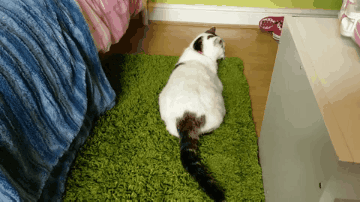This is my cat, Marzipan, responding to some catnip I rubbed on the floor. She usually responds by rolling around but other behaviours often seen include licking, sniffing, biting, drooling and kicking. The effects typically last for 5-15 minutes and after it wears off, they won’t respond again for about 30 minutes. Have you ever wondered why cats respond like this to catnip?
Catnip, or Nepeta cataria to give it it’s Sunday name, is a member of the mint family. A common defence mechanism of plants is to release allomones (chemicals that affect the behaviour of another species) to repel insects that want eat them. One of these made by the catnip plant is called nepetalactone and coincidentally, it attracts cats. Around two thirds of domestic cats respond to catnip and it’s thought to be hereditary. Large species of cats including lions and jaguars are really sensitive to catnip with effects lasting up to an hour. Tigers, on the other hand, usually don’t respond at all. And it’s not just catnip that’s special. Silver vine, valerian root and Tatarian honeysuckle wood contain chemicals very similar to nepetalactone which also cause this euphoric response in cats.
The response is triggered when cats smell the nepetalactone. From some crazy experiments done in the 1980s, we know removal of the olfactory bulbs (part of the brain involved in sense of smell) leads to loss of the catnip response in cats. Although Marzipan likes to eat leaves from our catnip plant, it’s been shown that cats given capsules containing nepetalactone did not respond. What’s going on in the brain is not really understood. It’s been suggested that brain cells in the olfactory bulb send signals to the amygdala and hypothalamus, regions of the brain involved in emotion. As cats commonly respond to catnip by rolling over, a behaviour also seen in female cats in heat, it was thought it was acting like pheromones found in the urine of male cats. Coming back to those experiments done in the 80s though, cats respond to catnip irrespective of whether they have a vomeronasal organ which is located in the nose and detects pheromones.
While we might not know what effect catnip is having on the brain, it is considered safe and non-addictive so go ahead and hook your cat up with his/her next fix.

